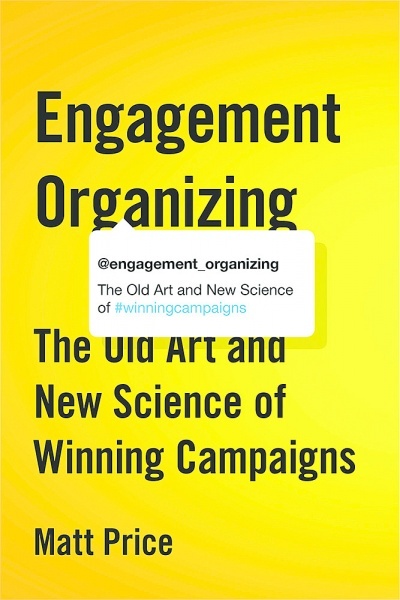
Blue Dot movement volunteers engage with the public in Vancouver. (Photo: Vincent Tom)
For some organizations and political parties, the idea of delegating control of a campaign to supporters is frightening.
In his new book, Engagement Organizing: The Old Art and New Science of Winning Campaigns, Matt Price makes the case that this is not only desirable, but essential for remaining relevant in today’s world, and provides insight as to how it can be done relatively painlessly.
Drawing upon over two decades of his own campaigning experience and examples from political, labour and non-profit spheres, Price explores how organizing has evolved over time, and identifies current best practices that are delivering wins.
As a campaign manager, I’ve wrestled with many of the issues addressed by this book. In three short years, the Blue Dot movement for environmental rights has recruited over 100,000 volunteers across the country, but it can be a challenge to engage meaningfully at this scale. In the past year we’ve tried to pivot from a successful municipal-level campaign to pursue federal legislation, and we have drawn upon engagement organizing principles to make sure that our supporters understand and buy in to this move. There’s always room for improving one’s organizing game, so this book immediately piqued my interest.
The book’s subtitle acknowledges that the concept isn’t new, and Price pays homage to organizing efforts based on intensive face-to-face relationship-building dating back to the 1930’s. He demonstrates how digital innovations have supercharged such efforts, allowing organizers to scale up while maintaining and tracking individual relationships. It provides a roadmap for how organizations can move from shallow “clicktivism” to deeper levels of engagement.
Price articulates well how digital innovations now allow for the tailoring of mass communication, providing more value to supporters, and how by asking people to do things and listening to their feedback, it increases campaign buy-in. The bonds created through collective action keep people showing up for more, and reduce the campaign-killing “flake factor.”
By asking people to do things and listening to their feedback, it increases campaign buy-in. The bonds created through collective action keep people showing up for more.
 Price shows how interactive online media has hastened the decline of the broadcast era, and increased people’s expectations of their ability to choose among many options and demand a more participatory experience, whether it be the information they read or the campaign they support. The volunteer is now firmly in the driver’s seat.
Price shows how interactive online media has hastened the decline of the broadcast era, and increased people’s expectations of their ability to choose among many options and demand a more participatory experience, whether it be the information they read or the campaign they support. The volunteer is now firmly in the driver’s seat.
The main strength of the book lies in the extensive personal interviews it draws upon, providing candid reflections on lessons learned in failure as well as success. In the spirit of storytelling, the core of any good engagement strategy, Price weaves together over a dozen case studies to demonstrate how these principles have been put into practice.
While the book draws extensively upon the U.S., Canadian readers will appreciate the homegrown examples of this concept being successfully put to use, including the Dogwood Initiative, LeadNow, and Organize BC. The book offers a detailed analysis of the 2015 federal election, and an insider’s perspective on the role that engagement organizing played therein. The case studies show that some very important innovations have occured in Canada during the past decade.
Readers who have worked for more established organizations may twitch as Price touches upon familiar “pain points” of why engagement organizing has proven difficult, including outdated data management systems and institutional inertia, often reflecting a fear of change and loss of control. Price allays these fears somewhat by identifying organizing parameters that can be established to ensure that things don’t go sideways in the course of scaling up and delegating control to local volunteers. Part of this involves establishing clear guidelines, messaging, materials, and structures of accountability. Leadership is delegated and distributed outward from HQ, but only to volunteers that pass a test. In this way, engagement organizing seeks a balance between rigid, top-down hierarchy and leaderless entropy.
In drawing parallels between the worlds of NGOs, unions and political campaigns, the book explores how each of these entities has grappled with the power shift required to embrace organizing. A recurring theme is that there are limitations and hazards to relying on paid staff or doing too much for supporters, instead of empowering volunteers to do things for themselves.
For some this book will serve as a refresher and bring to light best practices with which to improve their existing engagement strategy, while for others new to the concept, it may trigger a bigger rethink of how to approach engaging with supporters. The principles at play in this book are broadly applicable, from organizing a block party, to starting a movement or winning an election. As some say, “organizing is always the answer,” and this book offers insight into what’s required to carry this out successfully. Just as importantly, it identifies pitfalls that can lead to poor execution, and the risks of not doing it at all.
This article was originally published in the National Observer and has been reprinted with permission. Read the article.


